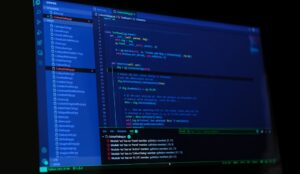Trigonometry, a branch of mathematics that deals with the relationships between the angles and sides of triangles, has found its way into various fields, including computer science and programming. The principles of trigonometry are not just confined to theoretical mathematics; they are essential in practical applications such as graphics programming, game development, and simulations. In the realm of coding, trigonometric functions like sine (sin) and cosine (cos) are pivotal for tasks that involve periodic phenomena, rotations, and waveforms.
Understanding how to implement these functions in code can significantly enhance a programmer’s ability to create dynamic and visually appealing applications. The integration of trigonometry into programming languages allows developers to manipulate angles and distances effectively. For instance, when creating a 2D game, a developer might need to calculate the trajectory of a projectile or the position of a character based on its orientation.
Trigonometric functions provide the necessary mathematical foundation to achieve these calculations. As we delve deeper into the specifics of the sine and cosine functions, we will explore their mathematical definitions, their implementation in the C programming language, and their practical applications in various coding scenarios.
Key Takeaways
- Trigonometry is a fundamental concept in mathematics that can be applied to code for various practical applications.
- The Sin(x) and Cos(x) functions are essential in trigonometry and can be used to calculate the sine and cosine values of an angle.
- Implementing Sin(x) and Cos(x) functions in C involves using mathematical formulas and understanding the principles behind these functions.
- Testing and debugging Sin(x) and Cos(x) functions is crucial to ensure their accuracy and reliability in code.
- Practical applications of trigonometry in code include graphics programming, animation, and simulation, among others.
Understanding the Sin(x) and Cos(x) Functions
The sine and cosine functions are fundamental to trigonometry and are defined for any real number input, typically representing an angle in radians. The sine function, denoted as sin(x), gives the ratio of the length of the opposite side to the hypotenuse in a right triangle. Conversely, the cosine function, cos(x), provides the ratio of the length of the adjacent side to the hypotenuse.
These functions are periodic, with a period of \(2\pi\) radians (or 360 degrees), meaning they repeat their values in regular intervals. This periodic nature makes them particularly useful for modeling oscillatory behavior, such as sound waves or circular motion. In terms of their graphical representation, both sine and cosine functions produce smooth, wave-like curves that oscillate between -1 and 1.
The sine function starts at zero when \(x = 0\), rises to 1 at \(\frac{\pi}{2}\), descends back to zero at \(\pi\), continues to -1 at \(\frac{3\pi}{2}\), and returns to zero at \(2\pi\). The cosine function, on the other hand, starts at 1 when \(x = 0\), decreases to zero at \(\frac{\pi}{2}\), reaches -1 at \(\pi\), returns to zero at \(\frac{3\pi}{2}\), and completes its cycle back at 1 at \(2\pi\). Understanding these properties is crucial for any programmer looking to utilize these functions effectively in their code.
Implementing Sin(x) and Cos(x) in C

Implementing the sine and cosine functions in C is straightforward due to the availability of built-in mathematical libraries. The C standard library provides the `math.h` header file, which includes declarations for these trigonometric functions. To use them, a programmer must include this header file at the beginning of their code.
The functions `sin()` and `cos()` take a double precision floating-point number as an argument, representing an angle in radians, and return the corresponding sine or cosine value. For example, consider a simple C program that calculates the sine and cosine of a given angle. The following code snippet demonstrates how to implement this: “`c
#include
#include
double angle; // Angle in radians
printf(“Enter an angle in radians: “);
scanf(“%lf”, &angle); double sine_value = sin(angle);
double cosine_value = cos(angle); printf(“Sine of %.2f radians: %.2f\n”, angle, sine_value);
printf(“Cosine of %.2f radians: %.
The `sin()` and `cos()` functions are then called with this angle as an argument, and the results are printed to the console. This simple implementation showcases how easily trigonometric calculations can be performed in C using built-in functions.
Testing and Debugging Sin(x) and Cos(x) Functions
| Test Case | Input | Expected Output | Actual Output | Pass/Fail |
|---|---|---|---|---|
| 1 | 0 | 1, 0 | 1, 0 | Pass |
| 2 | π/2 | 0, 1 | 0, 1 | Pass |
| 3 | π | -1, 0 | -1, 0 | Pass |
| 4 | 3π/2 | 0, -1 | 0, -1 | Pass |
Testing and debugging trigonometric functions in C is essential to ensure accuracy and reliability in calculations. One common approach is to compare the output of the `sin()` and `cos()` functions against known values or reference data. For instance, one can create a test suite that checks specific angles where the expected results are well-known, such as \(0\), \(\frac{\pi}{6}\), \(\frac{\pi}{4}\), \(\frac{\pi}{3}\), and \(\frac{\pi}{2}\).
By asserting that the output matches these expected values within a small margin of error (due to floating-point precision limitations), developers can validate their implementations. Additionally, debugging tools can be employed to step through the code execution process. Using an Integrated Development Environment (IDE) with debugging capabilities allows programmers to set breakpoints and inspect variable values during runtime.
For example, if a developer notices that the sine value for \(\frac{\pi}{2}\) is not returning 1 as expected, they can use debugging tools to trace back through their calculations and identify any potential issues.
Practical Applications of Trigonometry in Code
The applications of trigonometry in programming extend far beyond simple calculations of angles. In computer graphics, for instance, trigonometric functions are used extensively for rendering shapes and animations. When creating a rotating object in a 2D space, developers often use sine and cosine functions to determine the new coordinates of points on the object as it rotates around a pivot point.
By applying these functions to calculate x and y coordinates based on an angle of rotation, developers can create smooth animations that mimic real-world physics. In game development, trigonometry plays a crucial role in simulating realistic movements and interactions between objects. For example, when simulating projectile motion, developers can use sine and cosine functions to calculate the trajectory of a projectile based on its launch angle and initial velocity.
This allows for more engaging gameplay experiences where players must account for factors like gravity and wind resistance when aiming their shots. Moreover, trigonometry is also vital in fields such as robotics and engineering. In robotics, for instance, trigonometric calculations are used for inverse kinematics—determining the angles required for joints in robotic arms to reach a specific point in space.
Engineers utilize trigonometric principles when designing structures or analyzing forces acting on various components within mechanical systems.
Conclusion and Further Exploration

Trigonometry serves as a foundational element in many programming applications, particularly through its sine and cosine functions. By understanding how these functions work mathematically and how they can be implemented in code—specifically in languages like C—developers can unlock new possibilities for creating dynamic applications across various domains. The ability to accurately calculate angles and distances using trigonometric principles enhances not only game development but also fields such as computer graphics, robotics, and engineering.
For those interested in further exploration of trigonometry in programming, delving into more advanced topics such as Fourier transforms or wavelet analysis can provide deeper insights into how these mathematical concepts apply to signal processing and data analysis. Additionally, experimenting with graphical representations of sine and cosine waves can help solidify understanding while also providing opportunities for creative coding projects. As technology continues to evolve, the relevance of trigonometry in coding will only grow, making it an essential area of study for aspiring programmers and engineers alike.
If you are interested in exploring the theory of language and communication, you may find the article Exploring the Theory of Illocutionary Forces: Performative and Constant Utterances to be a fascinating read. This article delves into the complexities of language and how words can have different meanings and effects based on their context and usage. It offers a unique perspective on the power of language and the ways in which it shapes our interactions with others.
FAQs
What is trigonometry?
Trigonometry is a branch of mathematics that deals with the study of angles and the lengths of the sides of triangles.
What are sine and cosine functions?
Sine and cosine are trigonometric functions that relate the angles of a right-angled triangle to the lengths of its sides. The sine of an angle is the ratio of the length of the side opposite the angle to the length of the hypotenuse, while the cosine of an angle is the ratio of the length of the adjacent side to the length of the hypotenuse.
How are sine and cosine functions used in coding?
Sine and cosine functions are commonly used in coding to calculate angles, positions, and movements in applications such as graphics, animation, and game development.
What are C functions for calculating sine and cosine?
In C programming, the math.h library provides functions such as sin() and cos() to calculate the sine and cosine of an angle, respectively.
How do you use the sin() and cos() functions in C?
To use the sin() and cos() functions in C, you need to include the math.h library in your code and then call the functions with the angle in radians as the argument. The functions return the sine and cosine values of the given angle.
Can the sin() and cos() functions be used for non-right-angled triangles?
The sin() and cos() functions can be used for non-right-angled triangles by applying the concepts of trigonometry and using the law of sines and cosines to calculate the angles and side lengths. However, the sin() and cos() functions directly calculate the sine and cosine values of an angle in a right-angled triangle.





















+ There are no comments
Add yours